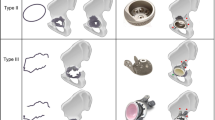Abstract
Purpose
The role of herniation pits as a radiographic indicator is still debated. This case–control study was to determine (1) the prevalence and sizes of herniation pits and (2) the relationship between herniation pits and femoral and acetabular bony morphology consistent with femoroacetabular impingement.
Methods
This comparative study was performed on 151 patients (151 hips; median patient age 46 years; range 16–73 years) with mechanical symptoms, who underwent multi-detector computed tomography (MDCT) arthrography (the symptomatic group), and an age-, gender-, site (left or right)-, and time (at diagnosis)-matched group of control patients that underwent multi-detector computed tomography due to an ureter stone (the asymptomatic group). Two orthopaedic surgeons reviewed images to evaluate the prevalence, sizes of herniation pits, and relationship with morphological abnormality.
Results
The prevalences of herniation pits in symptomatic and asymptomatic groups were 23.8 % (36/151) and 3.3 % (5/151), respectively (OR 9.14, 95 % CI 3.47–24.30; p < 0.001). Herniation pits were found to be significantly associated with pincer-type abnormality (p = 0.034), especially central acetabular retroversion (p < 0.001).
Conclusions
This study shows that the prevalence of herniation pits is higher in symptomatic patients with femoroacetabular impingement, and herniation pits are associated with central acetabular retroversion. Furthermore, herniation pits were also found to be a useful predictor of pincer-type femoroacetabular impingement.
Level of evidence
III.


Similar content being viewed by others
References
Amstutz HC, Thomas BJ, Jinnah R, Kim W, Grogan T, Yale C (1984) Treatment of primary osteoarthritis of the hip. A comparison of total joint and surface replacement arthroplasty. J Bone Joint Surg Am 66(2):228–241
Beall DP, Sweet CF, Martin HD, Lastine CL, Grayson DE, Ly JQ, Fish JR (2005) Imaging findings of femoroacetabular impingement syndrome. Skeletal Radiol 34(11):691–701
Beck M, Kalhor M, Leunig M, Ganz R (2005) Hip morphology influences the pattern of damage to the acetabular cartilage: femoroacetabular impingement as a cause of early osteoarthritis of the hip. J Bone Joint Surg Br 87(7):1012–1018
Crabbe JP, Martel W, Matthews LS (1992) Rapid growth of femoral herniation pit. AJR Am J Roentgenol 159(5):1038–1040
Hong SJ, Shon WY, Lee CY, Myung JS, Kang CH, Kim BH (2010) Imaging findings of femoroacetabular impingement syndrome: focusing on mixed-type impingement. Clin Imaging 34(2):116–120
Jamali AA, Mladenov K, Meyer DC, Martinez A, Beck M, Ganz R, Leunig M (2007) Anteroposterior pelvic radiographs to assess acetabular retroversion: high validity of the “cross-over-sign”. J Orthop Res 25(6):758–765
Karachalios T, Karantanas AH, Malizos K (2007) Hip osteoarthritis: what the radiologist wants to know. Eur J Radiol 63(1):36–48
Kassarjian A, Yoon LS, Belzile E, Connolly SA, Millis MB, Palmer WE (2005) Triad of MR arthrographic findings in patients with cam-type femoroacetabular impingement. Radiology 236(2):588–592
Kim JA, Park JS, Jin W, Ryu K (2011) Herniation pits in the femoral neck: a radiographic indicator of femoroacetabular impingement? Skeletal Radiol 40(2):167–172
Laborie LB, Lehmann TG, Engesaeter IO, Eastwood DM, Engesaeter LB, Rosendahl K (2011) Prevalence of radiographic findings thought to be associated with femoroacetabular impingement in a population-based cohort of 2081 healthy young adults. Radiology 260(2):494–502
Leunig M, Beck M, Kalhor M, Kim YJ, Werlen S, Ganz R (2005) Fibrocystic changes at anterosuperior femoral neck: prevalence in hips with femoroacetabular impingement. Radiology 236(1):237–246
Montgomery AA, Graham A, Evans PH, Fahey T (2002) Inter-rater agreement in the scoring of abstracts submitted to a primary care research conference. BMC Health Serv Res 2(1):8
Nokes SR, Vogler JB, Spritzer CE, Martinez S, Herfkens RJ (1989) Herniation pits of the femoral neck: appearance at MR imaging. Radiology 172(1):231–234
Notzli HP, Wyss TF, Stoecklin CH, Schmid MR, Treiber K, Hodler J (2002) The contour of the femoral head-neck junction as a predictor for the risk of anterior impingement. J Bone Joint Surg Br 84(4):556–560
Panzer S, Augat P, Esch U (2008) CT assessment of herniation pits: prevalence, characteristics, and potential association with morphological predictors of femoroacetabular impingement. Eur Radiol 18(9):1869–1875
Petersilge CA, Haque MA, Petersilge WJ, Lewin JS, Lieberman JM, Buly R (1996) Acetabular labral tears: evaluation with MR arthrography. Radiology 200(1):231–235
Pitt MJ, Graham AR, Shipman JH, Birkby W (1982) Herniation pit of the femoral neck. AJR Am J Roentgenol 138(6):1115–1121
Reynolds D, Lucas J, Klaue K (1999) Retroversion of the acetabulum. A cause of hip pain. J Bone Joint Surg Br 81(2):281–288
Tannast M, Siebenrock KA, Anderson SE (2007) Femoroacetabular impingement: radiographic diagnosis–what the radiologist should know. AJR Am J Roentgenol 188(6):1540–1552
Tannast M, Siebenrock KA, Anderson SE (2008) Femoroacetabular impingement: radiographic diagnosis–what the radiologist should know. Radiologia 50(4):271–284
Tonnis D, Heinecke A (1999) Acetabular and femoral anteversion: relationship with osteoarthritis of the hip. J Bone Joint Surg Am 81(12):1747–1770
Wiberg G (1939) Studies on dysplastic acetabula and congenital subluxation of the hip joint. Acta Chir Scand 83:1–135
Conflict of interest
The authors did not receive any outside funding or grants in support of their research for or preparation of this work. Neither they nor a member of their immediate families received payments or other benefits or a commitment or agreement to provide such benefits from a commercial entity. No commercial entity paid or directed, or agreed to pay or direct, any benefits to any research fund, foundation, division, centre, clinical practice, or other charitable or non-profit organization with which the authors, or a member of their immediate families, are affiliated or associated.
Author information
Authors and Affiliations
Corresponding author
Rights and permissions
About this article
Cite this article
Ji, HM., Baek, JH., Kim, KW. et al. Herniation pits as a radiographic indicator of pincer-type femoroacetabular impingement in symptomatic patients. Knee Surg Sports Traumatol Arthrosc 22, 860–866 (2014). https://doi.org/10.1007/s00167-013-2777-4
Received:
Accepted:
Published:
Issue Date:
DOI: https://doi.org/10.1007/s00167-013-2777-4




